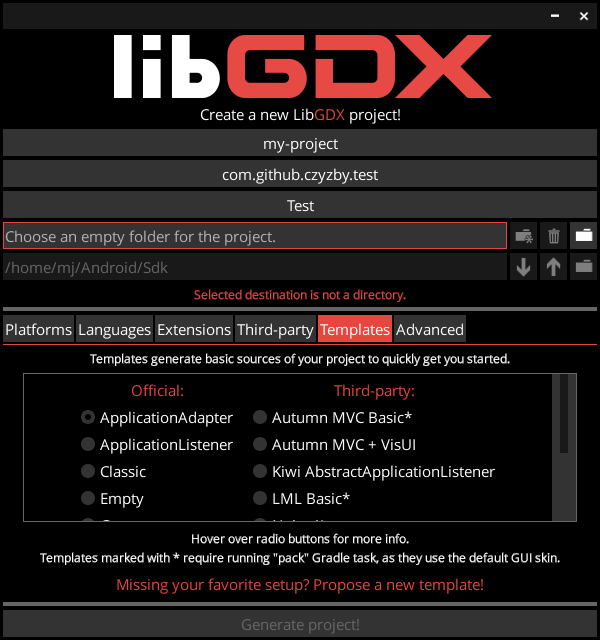This project is meant to be a replacement for the current gdx-setup application, which... well, has its flaws.
The biggest of which is Swing usage.
Additionally to supporting most official gdx-setup features, you might want to consider switching because of:
- Project templates. You can choose the initial generated sources of the project - you're no longer forced to use
ApplicationAdapterand BadLogic logo. (No offence, guys!) - Input validation. Your project data is validated as you type it in.
- Other JVM languages support. You can choose additional languages for your project - their runtime libraries, Gradle plugins and source folders will be included.
- Assets folder is now in the root directory and is properly linked by all projects. No more missing resources for the desktop project.
- Much more settings. You have more control over the versions of software used by your application.
- More third-party extensions. Much, much more.
- Preferences, favorites. Basic data of your application is saved, so you don't have to fill it each time you generate a project. File chooser allows you to add your "favorite" workspace folders.
- Internationalization! The application can be translated to different languages. It's currently available in English and Polish.
- Gradle wrapper and running Gradle tasks after generation is entirely optional. This can significantly speed up the generation process and limit the project size if you'd prefer to use a globally installed Gradle application.
- There are no major structural differences between any generated projects, regardless of the platforms
you initially used. Official
gdx-setupputs assets inandroidor - if Android platform is not supported -corefolders. If you don't start with the Android platform, adding it to an existing project would require a lot of moving around and modifying Gradle scripts. Usually you'd be better off just generating a new project and moving the code. On contrary, this application putsassetsin the root folder - adding a new platform to an existing application never requires you to modify any of the other platforms, you just have to add the new project tosettings.gradleand create its directory.
You can download the latest runnable jar HERE. The latest version usually contains up-to-date third-party library versions. Stable application versions are uploaded to the releases section.
Pro tip: check the Generate skin assets option in Advanced tab and Desktop in Platforms tab.
Enter pack desktop:run --daemon Gradle tasks in Advanced tab. Delete project directory with the trash icon
after each run. Now you can easily test all project templates one by one. Find the one that suits you best.
git clone https://github.com/czyzby/gdx-setup.git
cd gdx-setup
gradle run
You can start with creating an issue: if that's something trivial like adding a new extension or updating some version, it will most likely be quickly resolved. If you want to modify the sources and pull a request, check out the contribution guide.
